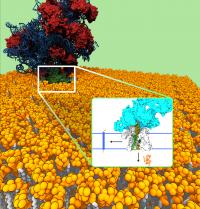
The ribosome (red-blue) in complex with the translocon channel (green), which is embedded in the cell membrane (yellow, white). Chemists at the California Institute of Technology (Caltech) have managed, for the first time, to simulate the biological function of a channel called the Sec translocon, which allows specific proteins to pass through membranes. The feat required bridging timescales from the realm of nanoseconds all the way up to full minutes, exceeding the scope of earlier simulation efforts by more than six orders of magnitude. The result is a detailed molecular understanding of how the translocon works.
Modeling behavior across very different timescales is a major challenge in modern simulation research. "Computer simulations often provide almost uselessly detailed information on a timescale that is way too short, from which you get a cartoon, or something that might raise as many questions as it answers," says Thomas Miller, an assistant professor of chemistry at Caltech. "We've managed to go significantly beyond that, to create a tool that can actually be compared against experiments and even push experiments—to predict things that they haven't been able to see."
The new computational model and the findings based on its results are described by Miller and graduate student Bin Zhang in the current issue of the journal Cell Reports.
The Sec translocon is a channel in cellular membranes involved in the targeting and delivery of newly made proteins. Such channels are needed because the proteins that are synthesized at ribosomes must travel to other regions of the cell or outside the cell in order to perform their functions; however, the cellular membranes prevent even the smallest of molecules, including water, from passing through them willy-nilly. In many ways, channels such as the Sec translocon serve as gatekeepers—once the Sec translocon determines that a given protein should be allowed to pass through, it opens up and allows the protein to do one of two things: to be integrated into the membrane, or to be secreted completely out of the cell.
Scientists have disagreed about how the fate of a given protein entering the translocon is determined. Based on experimental evidence, some have argued that a protein's amino-acid sequence is what matters—that is, how many of its amino acids interact favorably with water and how many clash. This argument treats the process as one in equilibrium, where the extremely slow rate at which a ribosome adds proteins to the channel can be considered infinitely slow. Other researchers have shown that slowing down the rate of protein insertion into the channel actually changes the outcome, suggesting that kinetic effects can also play a role.
"There was this equilibrium picture, suggesting that only the protein sequence is really important. And then there was an alternative picture, suggesting that kinetic effects are critical to understanding the translocon," Miller says. "So we wondered, could both pictures, in some sense, be right? And that turns out to be the case."
In 2010 and earlier this year, Miller and Zhang published papers in the Proceedings of the National Academy of Sciences and the Journal of the American Chemical Society describing atomistic simulations of the Sec translocon. These computer simulations attempt to account for every motion of every single atom in a system—and typically require so much computing time that they can only model millionths of seconds of activity, at most. Meanwhile, actual biological processes involving proteins in the translocon last many seconds or minutes.
Miller and Zhang were able to use their atomistic simulations to determine which parts of the translocon are most important and to calculate how much energy it costs those parts to move in ways that allow proteins to pass through. In this way, they were able to build a simpler version of the simulation that modeled important groupings of atoms, rather than each individual atom. Using the simplified simulation, they could simulate the translocon's activity over the course of more than a minute.
The researchers ran that simplified model tens of thousands of times and observed the different ways in which proteins move through the channel. In the simulation, any number of variables could be changed—including the protein's amino-acid sequence, its electronic charge, the rate at which it is inserted into the translocon, the length of its tail, and more. The effect of these alterations on the protein's fate was then studied, revealing that proteins move so slowly within the tightly confined environment of the translocon that the pace at which they are added to the channel during translation—a process that might seem infinitely slow—can become important. At the same time, Miller and Zhang saw that other relatively fast processes give rise to the results associated with the equilibrium behavior.
"In fact, both equilibrium and kinetically controlled processes are happening—but in a way that was not obvious until we could actually see everything working together," Miller says.
Beyond elucidating how the translocon works and reconciling seemingly disparate experimental results, the new simulation also lets the researchers perform experiments computationally that have yet to be tried in the lab. For example, they have run simulations with longer proteins and observed that at such lengths—unlike what has been seen with shorter proteins—the equilibrium picture begins to be affected by kinetic effects. "This could bring the two experimental camps together, and to have led that would be kind of exciting," Miller says.
Source : California Institute of Technology
 Print Article
Print Article Mail to a Friend
Mail to a Friend
